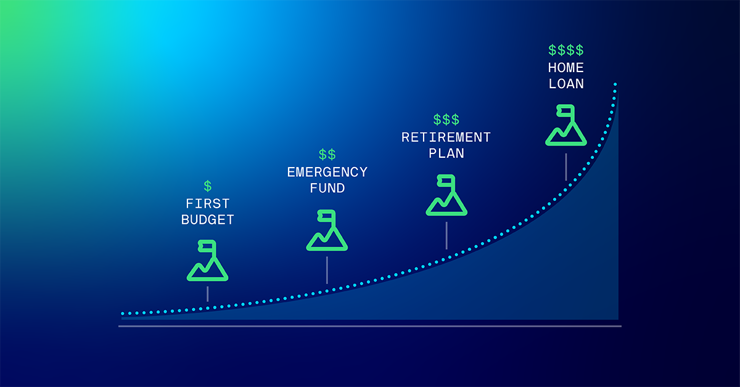Financial literacy programs: the secret weapon for banking customer engagement
By transforming content channels into educational powerhouses, banks can foster deeper customer engagement, build unwavering loyalty, and contribute meaningfully to the financial well-being of their communities. Here's how.


Banks are no longer just facilitators of transactions. There’s a real golden opportunity for financial institutions to redefine their roles in the greater economic landscape.
Imagine a world where your bank's website and mobile app are not just tools for managing accounts, but vibrant educational platforms that empower customers with the financial knowledge they need to thrive. By transforming content channels into educational powerhouses, banks can foster deeper customer engagement, build unwavering loyalty, and contribute meaningfully to the financial well-being of their communities.
A new era of customer engagement in banking
63% of Americans admit they struggle with money, and 55% feel uncertain about their financial decisions. This highlights a pressing need for banks to actively engage in financial education.
Banks must move beyond traditional transactional interactions and adopt a new approach where every customer touchpoint feels like a personalized financial coaching session. This shift isn't merely aspirational; it represents a strategic opportunity.
By leveraging financial literacy programs, banks can transform their role from passive service providers to trusted advisors. This proactive approach doesn't just benefit customers by providing them with tailored advice and interactive tools, it also offers substantial advantages for the banks themselves. Enhanced customer engagement through financial education leads to improved customer retention and opens new opportunities for product conversion.
So, how can banks overhaul their content channels to facilitate this deeper, more meaningful engagement? It starts with a commitment to integrating financial literacy into every interaction, turning each customer touchpoint into an opportunity for education and personalized guidance.
Transforming content channels into educational powerhouses
To truly capitalize on the potential of financial literacy programs, banks need to rethink their content strategies. This involves transforming traditional content channels into dynamic, interactive educational hubs that cater to the specific needs of their customers. Here’s how banks can achieve this transformation:
Engaging content
It’s time to move beyond generic financial tips. Banks should create content that resonates with their audience’s specific needs and interests. For example, a blog series on retirement planning could include interactive tools for calculating retirement savings, guest posts from financial experts, and real-life success stories.
- Optimizely Tip: By leveraging Optimizely’s Platform, banks can experiment with different content formats and personalize them to match customer preferences, ensuring that each piece of content speaks directly to the individual reader.
Interactive webinars and learning programs
Launching comprehensive online courses and interactive webinars is a game-changer in financial education. These programs can offer structured learning paths covering a range of financial topics—from basic budgeting to advanced investment strategies.
- Optimizely Tip: Using Optimizely’s Web Experimentation, banks can test different course formats and delivery methods to determine which approaches best engage their audience. This allows for continuous improvement in how educational content is presented, ensuring that customers are not just passive learners but active participants in their financial education.
Dynamic tools and resources
Imagine giving your customers access to personalized financial tools right on your bank’s digital platforms. Tools like budgeting calculators, savings goal trackers, and financial health quizzes can help customers apply what they’ve learned directly to their own financial situations.
- Optimizely Tip: With Optimizely’s Personalization capabilities, these tools can be tailored to the unique financial behaviors and goals of each user, offering customized advice on topics like debt management, retirement planning, and credit building.
As banks continue to innovate in these areas, they are also setting trends that are defining the future of financial literacy. Let’s take a closer look at some of these emerging trends and how traditional banks are leading the way in making financial education a cornerstone of customer engagement.
Financial literacy trends in banking: what banks are doing right
As financial institutions evolve, a significant shift is occurring in how they approach customer engagement and education. Banks are increasingly embracing financial literacy as a cornerstone of their strategies, recognizing that informed customers are more likely to remain loyal and make sound financial decisions. Here are some of the most intriguing trends in financial literacy within the banking industry, along with examples of how traditional banks are leading the charge:
Expansion of digital learning platforms
With the rise of digital channels, banks are increasingly using online platforms to deliver financial literacy content. This trend reflects the need to meet customers where they are and provide educational resources that fit into their digital lifestyles.
- Example: Wells Fargo has launched the “Hands on Banking” program, which provides free online courses covering topics from budgeting to retirement planning. This initiative aims to equip customers with practical skills to manage their finances better.
Optimizely is a 8x Leader in CMPs!
Personalized financial education
Leveraging data analytics and AI, banks are increasingly able to offer personalized financial advice and educational content. This trend highlights a shift from one-size-fits-all solutions to tailored financial guidance based on individual customer needs and behaviors. For example, banks can now offer personalized advice on improving your credit score, create customized savings plans for buying a new car, or provide strategies to eliminate PMI faster.
- Example: Bank of America’s virtual assistant, Erica, uses AI to offer personalized financial insights and guidance. By analyzing spending patterns and financial goals, Erica provides users with relevant advice and resources to improve their financial health.
Integration of gamification
To make financial education more engaging, banks are incorporating gamification elements into their learning programs. This approach not only makes financial concepts more accessible but also encourages customers to actively participate in their financial learning journey.
- Example: Banco Santander's participation in Finanzas para Mortales (Finance for Mortals) program incorporates interactive games and challenges to enhance financial education for diverse groups, including the elderly and those at risk of exclusion. This gamified approach aims to make financial learning more engaging and effective, supporting Santander's goal of exceeding its financial inclusion target of 10 million people by 2025.
Collaboration with nonprofits and educational institutions
Banks are forming partnerships with nonprofits and educational organizations to enhance their financial literacy programs. These collaborations help leverage external expertise and reach a broader audience.
- Example: HSBC has partnered with Junior Achievement Worldwide to expand financial literacy education globally. This collaboration focuses on providing young people with practical financial skills and entrepreneurial education through interactive programs and resources. The partnership aims to reach underserved communities and equip students with essential financial knowledge for their future.
These trends are not just shaping the future of banking but also redefining the role of banks within their communities. As banks continue to innovate and lead in financial literacy, they are also fostering deeper connections with their customers and contributing to the financial health of the broader community.
Building trust through personalized education
Trust is the cornerstone of any successful banking relationship, and there’s no better way to build trust than by providing customers with valuable, actionable financial advice. When customers feel that their bank is genuinely invested in their financial well-being, they are more likely to remain loyal and engage more deeply with the bank’s offerings.
For instance, imagine using Optimizely’s platform to deliver personalized credit-building strategies. Based on a customer’s credit history and financial behavior, the bank could offer customized education resources, secured credit card options, and credit monitoring services. This kind of tailored approach not only helps customers build and maintain healthy credit profiles but also strengthens their trust in the bank as a reliable partner in their financial journey.
Fostering customer loyalty
The benefits of financial literacy programs extend far beyond immediate customer engagement. When banks take an active role in supporting their customers’ financial wellness, they create a ripple effect that enhances overall customer loyalty. Deloitte’s study found that nearly half of the customers who received relevant financial advice from their bank opened new accounts with that institution. This highlights the powerful impact of educational initiatives on customer retention and growth.
By investing in financial literacy, banks can foster a sense of loyalty that transcends simple transactions. Customers who feel empowered by their bank’s educational offerings are more likely to stick around and explore other products and services, knowing that their financial institution has their best interests at heart.
Empowering communities for the future
Financial literacy programs do more than just boost customer engagement—they can transform the financial well-being of entire communities while also reducing risk for banks. By helping customers improve their credit scores and make informed financial decisions, banks not only empower individuals but also secure lower-risk borrowers, which is critical for the bank's own stability.
Empowered customers make better financial choices, leading to increased economic stability within their households and the broader community. As more individuals achieve financial success, the benefits ripple outward, contributing to a healthier local economy. For banks, promoting financial literacy is an investment in both customer relationships and the long-term prosperity of the communities they serve. By reducing financial risk at the individual level, banks are also fortifying the financial resilience of their communities, creating a stronger, more sustainable future for all.
Conclusion
As the banking industry continues to evolve in an increasingly competitive landscape, financial literacy programs offer a compelling opportunity for differentiation. By transforming their content channels into hubs of education, banks can position themselves as proactive, engaged partners in their customers’ financial journeys. This approach not only enhances the customer experience but also drives long-term loyalty and trust.
Optimizely provides the perfect platform for banks to implement and optimize these financial literacy initiatives. By leveraging its capabilities, banks can create a more personalized, engaging, and effective educational experience that truly resonates with their customers.
The future of banking lies in education. By embracing financial literacy as a core strategy, banks can not only meet the immediate needs of their customers but also empower them to achieve lasting financial success. This isn’t just about numbers—it’s about making a real impact in the lives of the people you serve. And with the right tools and strategies, that impact can be profound.

